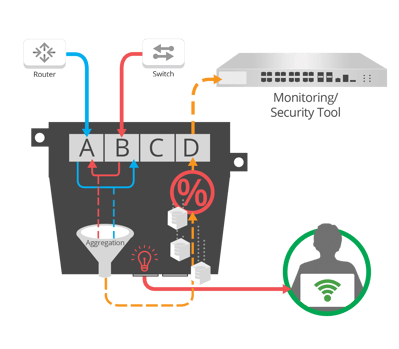

For network IT managers that send data to monitoring tools, the concern about oversubscribed ports is a continual battle. You can’t always predict your network traffic, and as you probably know - problems arise at the worst times possible.
Some network TAP manufacturers promote buffering as an option to avoid oversubscription. But buffering is a bluff, at best it’s a band aid approach and at its' worst it’s a falsehood that introduces new latency and timing issues into the environment.
To guarantee (yes, I said guarantee) never oversubscribing ports, the foolproof method is to introduce filtering + aggregation.
Garland’s got it and is the only TAP vendor to offer this advanced functionality in both portable and rack mounted TAPs or a chassis solution.
In my recent blog, The Buffering Bluff on Aggregation TAPs, I went over how buffering creates a false sense of security. Here’s a quick recap:
Consider the following from Wireshark expert Andrew Brown in his 2014 Sharkfest presentation, Maximizing Packet Capture Performance:
That means that even a 1,000 MB buffer on a copper GB network TAP would reach capacity in just 89.8 seconds. Clearly, this can’t be considered an effective solution to traffic management challenges.
In our new filtering TAPs, the GUI /CLI remote management interface allows you to set up utilization alerts for each monitoring port. Most users start off with a standardized percentage such as 50%, the percentage can be changed for each monitoring port based on your network traffic.
Once an alert is triggered, you can remotely change TAP mode to breakout to avoid oversubscription, or you can set up filtering rules.

With Garland’s 1G Portable Filtering TAP, you are able to filter and aggregate traffic to 1 or 2 monitoring tools. This filtering TAP is ideal for remote locations such as retail, banking, etc.
Garland’s 1U and 2U 1G Chassis, provides additional functionality with modular filtering TAPs.With port mapping (aka: filtering backplane) you can filter and aggregate up to four 1G links and send the data to a monitoring tool or analyzer and only use one port on the analyzer. This minimizes the number of monitoring ports required and saves budget.
Now that we’ve uncovered the truth about filtering + aggregation, and you know the falsehood of buffering, take a deeper dive on filtering and download our free eBook, Network TAPs 101: The Networking User Guide.
If the inline security tool goes off-line, the TAP will bypass the tool and automatically keep the link flowing. The Bypass TAP does this by sending heartbeat packets to the inline security tool. As long as the inline security tool is on-line, the heartbeat packets will be returned to the TAP, and the link traffic will continue to flow through the inline security tool.
If the heartbeat packets are not returned to the TAP (indicating that the inline security tool has gone off-line), the TAP will automatically 'bypass' the inline security tool and keep the link traffic flowing. The TAP also removes the heartbeat packets before sending the network traffic back onto the critical link.
While the TAP is in bypass mode, it continues to send heartbeat packets out to the inline security tool so that once the tool is back on-line, it will begin returning the heartbeat packets back to the TAP indicating that the tool is ready to go back to work. The TAP will then direct the network traffic back through the inline security tool along with the heartbeat packets placing the tool back inline.
Some of you may have noticed a flaw in the logic behind this solution! You say, “What if the TAP should fail because it is also in-line? Then the link will also fail!” The TAP would now be considered a point of failure. That is a good catch – but in our blog on Bypass vs. Failsafe, I explained that if a TAP were to fail or lose power, it must provide failsafe protection to the link it is attached to. So our network TAP will go into Failsafe mode keeping the link flowing.
Single point of failure: a risk to an IT network if one part of the system brings down a larger part of the entire system.
Heartbeat packet: a soft detection technology that monitors the health of inline appliances. Read the heartbeat packet blog here.
Critical link: the connection between two or more network devices or appliances that if the connection fails then the network is disrupted.